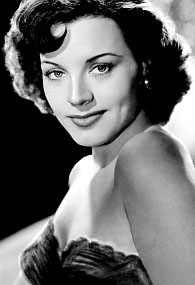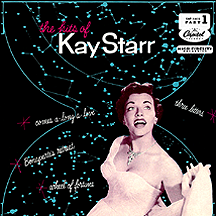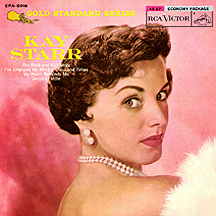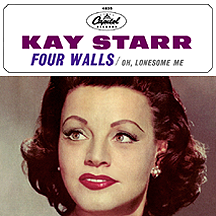KAY STARR
While growing up in the 1920s and '30s, Kay Starr's parents exposed her to all types of music: classical, blues, jazz, country, big band. Her eventual career as a singer encompassed all of these influences. Interestingly, she usually found herself competing with a variety of artists in a race to hit the charts with the same potential hit song. She wasn't much of a trailblazer when it came to choosing original material suited to her, but what a voice! The selections didn't have to be tailor-made for Kay's talents; she could handle anything and everything. Born Katherine Starks in Oklahoma in 1922 of Iriquois Indian and Irish descent, her family moved to Dallas a few years later. During Kay's elementary school years, family and friends noticed a natural inclination towards singing and before long she was displaying her range on a local radio station. A move to Memphis by the time she was a teenager brought more radio opportunities, followed by a chance to sing with a band at the age of 15. Adulthood came early for Kay. By the time she graduated from high school, she had already put in a couple of years with the Joe Venuti orchestra.
In the summer of 1939, Kay sang briefly with the Glenn Miller band as a fill-in when his regular vocalist, Marion Hutton, fell ill. A recording session resulted; "Baby Me" revealed an atypically mature and confident 17-year-old performer. It didn't lead to anything further, though, and she continued with Venuti, followed by 1940s stints with Wingy Manone and Charlie Barnet. In 1947, a time when more and more singers were abandoning the big bands in favor of solo careers and more control, Kay signed a contract with Capitol Records.
At first she played follow-the-leader, a common practice in the '40s and '50s though not necessarily a solid strategy for extended success...but in the long run she beat the odds, often outselling the original artists' recordings. Blue Barron's 1948 hit "You Were Only Fooling" (with lead singer Clyde Burke) became a sizeable hit for Kay as well in early '49, her first to appear on the best seller charts. Just a few weeks later her cover of Russ Morgan's "So Tired" clicked. Exposure in two Hollywood movies, Make Believe Ballroom in 1949 and When You're Smiling in 1950, helped familiarize the largely unknown singer to a wider audience. The new decade found her going after Perry Como with the polka-flavored "Hoop-Dee-Doo" before making her first detour into country territory. Pee Wee King's fiddle-heavy "Bonaparte's Retreat" took a brassy turn in Kay's hands with the help of Lou Busch's backing band and landed her in the top ten for the first time.
The George Weiss-Bennie Benjamin song "I'll Never Be Free" was extremely popular in the rhythm and blues market, first appearing by Paul Gayten's band (with vocalist Annie Laurie) in April 1950, followed by a country cover by Starr and Tennessee Ernie Ford (in those days billed simply as Tennessee Ernie), a 180-degree turn from the Gayten version. There were other hit R&B renditions of the song by Dinah Washington, Lucky Millinder featuring singer Annisteen Allen, and a duet by Ella Fitzgerald and Louis Jordan. Another multiple-artist hit, the Louis Prima-Milton Kabak composition "Oh Babe" appeared in November by Jimmy Preston with vocalist Burnetta Evans, followed by Kay Starr's pop take, then three more R&B versions (Larry Darnell, Wynonie Harris and Roy Milton) and several pop covers (the biggest, next to Kay's, being the original by Prima and Keely Smith).
"Wheel of Fortune," another song by Weiss and Benjamin, is the most famous of Kay Starr's achievements, even though a version by Eddie Wilcox and Sunny Gale got the jump on her by one week in early 1952. An actual roulette wheel supplied the sound effect at the late night studio session, with numerous takes required to get the sound and timing of the wheel's spin just right. Kay's bigger-than-life performance sent the song 'spinning, spinning, spinning' to number one for more than two months. For a time after this she was the leader other acts pursued, waxing hit after hit including "Comes A-Long A-Love," "Side By Side" and "Half a Photograph," with no cover competition in sight. The downside of this successful period was that the music stayed in more of a pop standard vein; the variety of influences that had energized her earlier recordings were less evident.
One exception was the summer '52 hit "Kay's Lament." Cowritten by Starr with Hal Stanley, the track featured a small jazz combo with a cool bongo beat and backing vocals by The Lancers ('Shout it, Sister Katy!'); it was blues and jazz rolled up into an R&B romp in the same vein as anything Washington or Ruth Brown was doing at the time. This and "Wheel" marked 1952 as the year Kay Starr was at the peak of her powers. In 1953 and '54 she stretched her categorical limits once again, venturing into gospel with "The Man Upstairs" and adapting a French opus, "Hymne a L'Amour," introduced four years earlier by Édith Piaf and retitled "If You Love Me (Really Love Me)." The two were released back-to-back and separately each was a top ten hit.

An unexpected music chart no-show in 1955 coincided with the expiration of Starr's Capitol contract. RCA Victor courted her and, opting for a fresh start, she switched labels. She must have spent a millisecond regretting her decision when RCA brass insisted she record a song by Dick Ware and Shorty Allen, "Rock and Roll Waltz," about a girl sneaking home late from a date and seeing her parents '...trying to waltz to a rock and roll song.' Surely it was just a joke and the real music they had in mind for her was more in line with common sense! But they weren't kidding, and Kay went into her first session with the task of credibly performing a pseudo-rock record. With backup provided by Hugo Winterhalter's orchestra, the end result has a standard pop sound but with perplexing lyrics given the widespread opinion at the time against rock and roll. But it didn't matter. The record was just weird enough (or cute enough) that it connected, and in February and March 1956 it was America's number one hit, two months before a bona fide rock and roll act, RCA's recently-acquired Elvis Presley, took over the top of the charts for the first time with "Heartbreak Hotel."
Kay had a nice run with RCA Victor, but none of her other hits came anywhere close to that initial single. "Second Fiddle," "Love Ain't Right" and "Jamie Boy" are all still fun to listen to, and she had a solid hit in 1957 with "My Heart Reminds Me" (based on an instrumental by Italian composer Camillo Bargoni, "Autumn Concerto"), though it was overshadowed by Della Reese's more popular chart debut (titled "And That Reminds Me"). RCA and Kay parted ways in 1959; a Sammy Cahn-James Van Heusen song, "I Couldn't Care Less," commemorated the exit.
She found her way back to Capitol, later focusing on a country-pop sound with songs like Buck Owens and Harlan Howard's "Foolin' Around" and the Marvin Moore-Jim Campbell song "Four Walls," previously a hit for both Jim Reeves and Jim Lowe in 1957. Add in a brief acting career with a handful of television roles (including the NBC movie The Pied Piper of Hamelin in 1957, a part on a 1962 episode of the series Mr. Smith Goes to Washington starring Fess Parker and a comedy turn on The Red Skelton Hour the same year), plus six marriages throughout the decades, and it's obvious Kay Starr had a penchant for variety in more areas than just her music career!
NOTABLE SINGLES:
- You Were Only Fooling - 1948
- So Tired - 1949
- Hoop-Dee-Doo - 1950
- Bonaparte's Retreat - 1950
- I'll Never Be Free - 1950
with Tennessee Ernie - Ain't Nobody's Business But My Own - 1950
with Tennessee Ernie - Oh, Babe - 1950
- Come On-A My House - 1951
- Wheel of Fortune - 1952
- I Waited a Little Too Long - 1952
- Kay's Lament /
Fool, Fool, Fool - 1952 - Comes A-Long A-Love - 1952
- Side By Side - 1953
- Half a Photograph /
Allez-Vous-En - 1953 - Changing Partners - 1954
- The Man Upstairs /
If You Love Me (Really Love Me) - 1954 - Rock and Roll Waltz /
I've Changed My Mind a Thousand Times - 1956 - Second Fiddle /
Love Ain't Right - 1956 - The Things I Never Had /
The Good Book - 1956 - Jamie Boy /
A Little Loneliness - 1957 - My Heart Reminds Me - 1957
- Rockin' Chair - 1958
- He Cha Cha'd In - 1958
- I Couldn't Care Less - 1959
- Riders in the Sky - 1959
- Foolin' Around - 1961
- I'll Never Be Free - 1961
- Four Walls - 1962
- When the Lights Go on Again (All Over the World) - 1967




